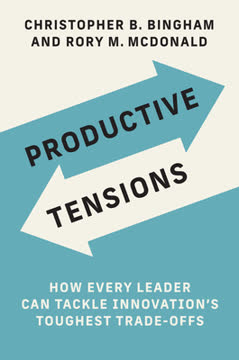Key Takeaways
1. Embrace the Tension: Innovation Thrives on Productive Contradictions
"Leaders who reinvent their businesses—deliberately becoming a different kind of organization (not jumping aimlessly from one failed venture to another)—shrink their chances of failure by conserving resources while continuing to learn more about customers, business partners, and new technologies."
Innovation is inherently contradictory. Successful innovation requires leaders to navigate seemingly opposing forces, such as efficiency versus flexibility, familiarity versus novelty, and consistency versus change. Rather than viewing these as painful trade-offs, effective innovators see them as productive tensions that can be harnessed to drive growth and creativity.
Anticipate and face tensions head-on. By recognizing and proactively addressing the inevitable contradictions in innovation, leaders can reduce the risk of stalling projects and better position their organizations to overcome obstacles. This approach allows for more nimble adaptation to unforeseen challenges and opportunities.
Balance is key. The most successful innovators are adept at managing these tensions, finding ways to embrace both sides of each contradiction as appropriate. This might mean being disciplined in opportunity selection while remaining flexible in execution, or emphasizing familiarity in early product framing before highlighting novelty later on.
2. Master the Opportunity Paradox: Balance Selection and Execution
"Shifting from an intense focus during selection to flexibility during execution promotes learning and provides maximum leeway for leaders to adjust adeptly to unforeseen realities."
Two-phase process. Opportunity capture involves distinct selection and execution phases. Leaders must recognize the different approaches required for each phase to maximize success.
Disciplined selection, flexible execution.
- Selection phase:
- Be focused and strategic
- Carefully analyze potential opportunities
- Consider how opportunities link together
- Execution phase:
- Embrace flexibility
- Be ready to adapt to new information
- Adjust tactics based on real-world feedback
Sequence for success. By approaching opportunities in this manner, organizations can build on past experiences while remaining agile enough to capitalize on emerging trends or pivot when necessary.
3. Parallel Play: Borrow Ideas Before Differentiating in New Markets
"Doing so requires resisting the urge to be precise about features or functionality, particularly early on."
Observe and experiment. In new markets, leaders should resist the urge to differentiate immediately. Instead, engage in "parallel play" by observing competitors, borrowing ideas, and testing various approaches before committing to a specific business model.
Staged approach to innovation:
- Observe: Watch what others in the market are doing
- Borrow: Adopt and adapt successful ideas from peers
- Test: Experiment with various borrowed and original concepts
- Commit: Choose a primary business model template
- Refine: Continuously update and improve based on market feedback
Maintain flexibility. Even after committing to a model, leaders should remain open to refinement. As the market matures and cause-effect relationships become clearer, be prepared to update your approach.
4. Data Dilemma: Know When to Defer and When to Ignore
"Not only can data be insufficient, they can get in the way."
Data isn't always king. While we live in an age of data analytics, truly groundbreaking innovations often begin with theories or paradigms for which supportive data doesn't yet exist. Leaders must learn when to rely on data and when to trust their instincts.
Create a data barrier. To protect innovative thinking:
- Separate data used in innovation processes from operational data
- Allow space for ideas that may not be supported by current metrics
- Cultivate a culture that values qualitative insights alongside quantitative data
Balance skepticism and openness. Develop a discerning orientation toward data, maintaining healthy skepticism about insights derived from existing information while remaining open to new possibilities that data might reveal.
5. Crowd Sequencing: Leverage Diverse Groups at Different Stages
"Crowd sequencing consists of using an assortment of crowds, or groups, to address different types of uncertainty related to innovation at different times."
Harness collective wisdom. To combat cognitive bias and construct a complete picture, leaders should leverage the expertise of diverse crowds, both internal and external to the organization.
Three-step approach:
- Solicit compressed feedback from diverse, unorganized groups
- Overdeliver for a small "love group" of early adopters
- Leverage weak-tie relationships for novel insights and resources
Timing is crucial. Different types of crowds are most valuable at specific stages of the innovation process. By sequencing crowd involvement strategically, leaders can accelerate innovation and navigate uncertainty more effectively.
6. Rational Heuristics: Simplify Complexity with Smart Rules of Thumb
"When environments become more complex, the best strategies are often the simplest."
Simplify decision-making. As organizations grow, they tend to accumulate policies and routines that can stifle flexibility. Heuristics—simple rules of thumb—can balance efficiency and adaptability in dynamic environments.
Types of heuristics:
- Selection: Distinguish between activities to pursue or ignore
- Procedure: Guide execution of selected activities
- Priority: Help rank activities
- Timing: Guide sequencing and pacing of activities
Maintain and refine. Regularly review and update heuristics to ensure they remain relevant and effective. Prune outdated rules and add new ones as needed, maintaining a balance between structure and flexibility.
7. Frame Innovations Effectively: Make the New Familiar, Then Novel
"It is novelty, after all, that attracts new audiences and creates new markets."
Two-stage framing. Customer perception often determines an innovation's success more than its technical merits. To gain traction, innovations must appear both familiar and novel.
Framing strategy:
- Early stage: Emphasize similarity to existing solutions
- After gaining acceptance: Highlight unique and valuable attributes
Transition tactics:
- Gradually increase specificity in describing novel aspects
- Make familiar aspects more generic over time
- Link new features to broader, relatable concepts
8. Build Purpose Brands: Align Products with Jobs to Be Done
"A purpose brand is a brand that is inextricably linked to a particular job to be done, becoming virtually synonymous with the job in prospective customers' minds."
Focus on customer needs. Create powerful purpose brands by aligning products with specific "jobs to be done"—the progress customers are trying to make in particular circumstances.
Three-step process:
- Identify the job: Understand functional, emotional, and social dimensions
- Design experiences: Ensure purchase and use precisely fulfill the job
- Align processes: Make the brand synonymous with the job
Extend thoughtfully. Once established, leverage purpose brands to endorse related products addressing similar jobs, but avoid diluting the brand's core association.
9. Pivot with Purpose: Maintain Consistency Amid Change
"To satisfy backers' demand for precision and differentiation in pitches, innovators risk spelling out who they are and what they are doing too early and too explicitly, before either is entirely clear."
Craft broad narratives. When pitching new ventures, resist the urge to be overly specific about features or functionality. Instead, focus on overarching goals and visions that allow room for adaptation.
Signal continuity during pivots:
- Link new directions to initial pitches and larger aims
- Emphasize consistency with broader societal missions
- Revisit and broaden original pitches rather than completely changing course
Communicate with empathy. When pivoting, move quickly but with humility. Express genuine concern for affected stakeholders and provide clear guidance on how changes will impact them.
Last updated:
Review Summary
The book Productive Tensions receives high praise from readers, with an overall rating of 4.57 out of 5. Reviewers describe it as a short, illustrative read for those interested in disruptive ventures and innovation. It's recommended for entrepreneurs, startups, and larger firms alike. The book explores eight dynamics that often hinder reliable innovation and provides guidance on navigating them. While mostly well-received, one reviewer noted some potentially conflicting recommendations. Overall, it's considered a valuable resource for innovation-focused readers.
Similar Books










Download PDF
Download EPUB
.epub digital book format is ideal for reading ebooks on phones, tablets, and e-readers.




